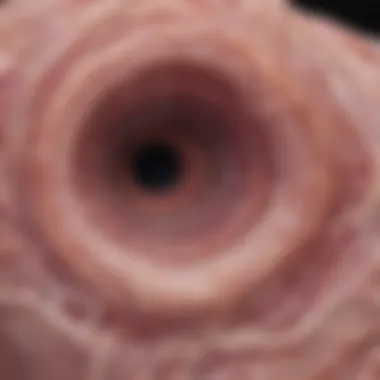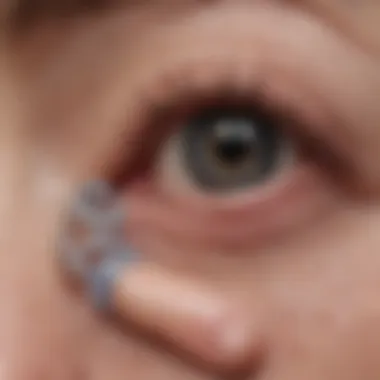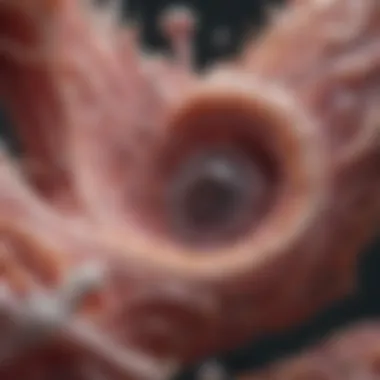Comedo Necrosis in Ductal Carcinoma In Situ


Intro
Comedo necrosis is a distinctive feature in the landscape of ductal carcinoma in situ (DCIS), presenting intriguing implications for diagnosis and treatment. Understanding its biological basis is crucial for healthcare professionals as they navigate the complex world of breast cancer pathology. This section aims to provide a solid foundation before delving into the specificities of comedo necrosis and its relevance in breast cancer.
As we consider the nuances of DCIS, it becomes evident that comedo necrosis not only alters how pathologists view tumor samples but also influences clinical decision-making. By analyzing morphological characteristics and their implications on patient prognosis, we can offer deeper insights into management strategies and enhance patient outcomes.
In our exploration, we will look at key findings in recent studies and how this understanding can reshape clinical practices in the oncology field.
Preface to Ductal Carcinoma In Situ
Ductal carcinoma in situ (DCIS) is a complex and critical condition that serves as an essential element within the broader landscape of breast cancer pathology. Understanding DCIS is not just about recognizing its presence; it is about grasping its implications, management, and relationship with invasive breast cancer. The importance of this topic lies in the increased incidence rates and the varying clinical approaches to treatment. As we delve into the specifics of DCIS, it is imperative to discuss its characteristics, risk factors, and especially the role of comedo necrosis, a type of necrosis often associated with DCIS.
This section will outline key aspects of DCIS that will inform subsequent discussions. An in-depth understanding of DCIS benefits medical professionals, researchers, and patients alike. It facilitates early detection and appropriate treatment planning, thereby enhancing patient outcomes. Through exploring the complexities surrounding this condition, we aim to shed light on the critical insights that impact diagnostic and treatment strategies.
Defining Ductal Carcinoma In Situ
Ductal carcinoma in situ is defined as a non-invasive breast cancer that originates within the ducts of the breast tissue. It is characterized by abnormal cell growth confined to the ductal epithelium. Importantly, DCIS does not invade surrounding breast tissue, which distinguishes it from invasive breast cancers.
DCIS is often detected through routine mammography screening, where characteristic microcalcifications may appear. When identified early, DCIS has a high cure rate and remains an area of active clinical research. Correctly classifying DCIS is vital to provide patients with relevant information and potential treatment pathways.
Epidemiology of DCIS
The epidemiology of DCIS reveals important trends in incidence and outcomes. According to statistical data, the rate of DCIS has risen significantly over the past few decades, primarily due to increased screening efforts. It is reported that approximately 20-30% of screen-detected breast cancers are classified as DCIS.
Certain factors influence the likelihood of developing DCIS, including age, family history, and genetic predispositions, such as mutations in the BRCA1 and BRCA2 genes. Moreover, women over the age of 50 have a higher risk of being diagnosed with DCIS. These epidemiological insights underscore the need for heightened awareness and screening, particularly in at-risk populations.
Importance of Early Detection
Early detection of ductal carcinoma in situ is paramount in improving clinical outcomes. Detecting DCIS at an early stage can significantly reduce the risk of progression to invasive breast cancer. Routine mammographic screenings and awareness about breast health play a crucial role in identifying DCIS before it becomes more complicated.
Detecting DCIS early facilitates a broader range of treatment options, allowing for approaches such as lumpectomy or breast-conserving surgery. Furthermore, patients diagnosed early are likely to experience favorable prognoses, making early detection a key strategy in clinical practice.
"The growth of knowledge in early detection contributes to the potential reduction in breast cancer mortality rates."
Understanding Comedo Necrosis
Understanding comedo necrosis is essential for grasping the full picture of ductal carcinoma in situ (DCIS). Comedo necrosis refers to a specific type of necrotic tissue that can be present in breast lesions. It often indicates a more aggressive form of DCIS and has significant implications for diagnosis and treatment. This section aims to elucidate the biological mechanisms at play and the distinct histological features that characterize this condition.
Pathophysiology of Comedo Necrosis
The pathophysiology of comedo necrosis, often associated with ductal carcinoma in situ, involves the interplay of tumor growth, cellular death, and biological signaling. In DCIS, there is abnormal proliferation of epithelial cells within the mammary ducts. When these cells experience rapid growth, their demand for nutrients may exceed the available blood supply, leading to localized ischemia. As a result, necrosis occurs. This type of necrosis is referred to as "comedo" necrosis, meaning it resembles a clogged pore.
Factors such as hypoxia, cell proliferation, and the tumor microenvironment contribute to necrotic cell death in DCIS. It is crucial to consider this mechanism when evaluating a DCIS diagnosis, as its presence may signal a higher risk of progression to invasive breast cancer. Understanding the pathophysiology can inform treatment choices and aid in predicting patient outcomes.
Histological Features of Comedo Necrosis
The histological features of comedo necrosis are distinct and can be readily identified under a microscope. In tissue samples displaying comedo necrosis, one may observe areas of necrotic debris within the ducts. This necrotic tissue typically exhibits eosinophilic (pink-stained) changes, contrasting sharply with surrounding viable cells.


Other notable features include:
- Calcification: Dystrophic calcifications often accompany necrotic areas.
- Apoptotic Cells: A mix of apoptotic cells may be present, indicating cell death through programmed mechanisms.
- Lymphocytic Infiltration: An inflammatory response may ensue, observable through the infiltration of lymphocytes surrounding necrotic areas.
These histological characteristics are pivotal for pathologists in diagnosing DCIS. Proper identification of comedo necrosis can indicate more aggressive forms of the disease, impacting treatment and surveillance strategies.
Comedo necrosis in DCIS is not merely a histopathological curiosity; it has tangible implications for disease management.
Grasping the importance of comedo necrosis involves recognizing its biological foundation and histological manifestations. By understanding both, practitioners can make more informed decisions regarding patient care.
Clinical Significance of Comedo Necrosis in DCIS
Comedo necrosis, a prominent histological feature in ductal carcinoma in situ (DCIS), plays a crucial role in understanding the clinical outcomes of this condition. Its presence can influence prognostic assessments and treatment strategies significantly. For pathologists and oncologists, recognizing comedo necrosis is essential to determining the aggressiveness of DCIS and tailoring patient management appropriately. Comedo necrosis is more than a mere histopathological finding; it carries implications for both clinical practice and research in breast cancer.
Impact on Prognosis
The presence of comedo necrosis in DCIS has been correlated with a poorer prognosis in various studies. This association suggests that tumors exhibiting this necrosis may display a higher likelihood of progression to invasive breast cancer.
Research indicates several factors linked to prognosis in patients with comedo necrosis:
- Tumor subtype: Comedo necrosis is more commonplace in high-grade tumors, which are often more aggressive.
- Tumor size and invasion: Larger tumors and those that show signs of invasion at diagnosis frequently demonstrate comedo necrosis.
- Lymphovascular invasion: Evidence of lymphovascular invasion in conjunction with comedo necrosis suggests an increased risk for metastasis.
Given these factors, clinicians might utilize the presence of comedo necrosis to stratify patients into high-risk categories. This stratification allows for closer monitoring and more aggressive treatment approaches when necessary.
"Comedo necrosis in DCIS could signal not just local disease but potentially impending systemic dissemination."
Association with Invasive Disease
An important facet of comedo necrosis lies in its statistical association with invasive disease. Studies show that patients with DCIS characterized by comedo necrosis are at a heightened risk for developing invasive carcinoma. This elevated risk highlights the role of histological assessment in predicting not just the behavior of DCIS, but also its potential evolution.
Some key points on this association include:
- Histological subtype correlation: Comedo necrosis is typically more associated with high-grade DCIS than with low-grade forms.
- Recurrence rates: Data suggests that recurrence rates are higher in patients with comedo necrosis following breast-conserving surgery.
- Invasive facilitation: The necrotic cellular changes may provide a milieu that favors invasive growth, thus increasing the chances for subsequent invasive carcinomas.
The correlation of comedo necrosis and invasive disease formation makes it a point of interest for ongoing research and clinical assessment. Updating treatment guidelines to incorporate findings related to comedo necrosis may be beneficial in both improving outcomes and guiding therapeutic decisions.
Diagnostic Techniques for Identifying Comedo Necrosis
Understanding how to accurately identify comedo necrosis is a crucial component in the diagnosis and management of ductal carcinoma in situ (DCIS). The detection of comedo necrosis provides critical insights into the aggressiveness of the tumor and influences treatment strategies. Accurate diagnosis through appropriate techniques can greatly impact clinical outcomes. Therefore, combining various diagnostic tools is essential in ensuring a comprehensive evaluation of this pathological feature.
Imaging Modalities
Imaging plays a significant role in identifying comedo necrosis. Mammography remains one of the primary imaging methods used in breast cancer screening. Characteristic features observed through mammography include clustered microcalcifications, which often indicate the presence of comedo necrosis. Other imaging modalities, such as breast ultrasound and magnetic resonance imaging (MRI), can assist in further characterizing the lesions and understanding the extent of disease.
- Mammography:
- Ultrasound:
- MRI:
- Highly effective in early detection of DCIS.
- May reveal areas of increased radiographic density.
- Can show calcium deposits formed from necrotic tissue.


- Useful for assessing masses not clearly visible on mammograms.
- Provides information about size and vascularity of lesions.
- Offers high sensitivity in identifying DCIS and surrounding tissue involvement.
- Can distinguish between invasive and non-invasive cancers more effectively.
In conjunction with imaging, histological evaluation is essential for confirming the presence of comedo necrosis.
Role of Biopsy
The biopsy remains the gold standard in the definitive diagnosis of comedo necrosis in DCIS. Different types of biopsy techniques can be utilized, each with its advantages and disadvantages. Understanding these techniques is paramount for providing patients with an accurate diagnosis and treatment plan.
- Core Needle Biopsy:
- Surgical Biopsy:
- Fine Needle Aspiration (FNA):
- Often used when suspicious lesions are detected via imaging.
- Allows for the collection of tissue samples for pathological examination.
- High accuracy in determining histological characteristics.
- Involves the excision of a larger tissue area.
- Benefits include the ability to assess the entire lesion and surrounding margins.
- Can also provide information on the tumor grade and size, essential for treatment planning.
- Less commonly used for comedo necrosis due to its lower specificity.
- Can be beneficial in certain situations for guiding further management decisions.
The integration of imaging techniques along with biopsy results builds a cohesive understanding of comedo necrosis in DCIS, ultimately leading to improved patient outcomes.
Accurate and timely diagnosis of comedo necrosis is critical in determining the therapeutic approach for ductal carcinoma in situ.
Treatment Considerations for DCIS with Comedo Necrosis
In the complex management of ductal carcinoma in situ (DCIS) with comedo necrosis, treatment strategies must consider multiple facets. The presence of comedo necrosis often influences therapeutic decisions due to its implications for prognosis and potential invasive behavior. Therefore, understanding the various treatment modalities is crucial for optimizing patient outcomes while addressing both immediate and long-term health concerns.
Surgical Interventions
Surgical intervention remains a cornerstone in the management of DCIS with comedo necrosis. The primary surgical option is usually lumpectomy, which aims to excise the tumor while preserving as much breast tissue as possible. However, depending on the extent of DCIS and the characteristics of comedo necrosis, mastectomy may be recommended.
- Lumpectomy is often accompanied by radiation therapy to reduce the risk of recurrence. This approach can effectively target residual cellular abnormalities, ensuring a comprehensive treatment.
- Mastectomy might be favored in instances of extensive disease, or if the patient has a family history of breast cancer, to minimize future risk. This decision must involve thorough discussion with the patient regarding their preferences and understanding of the potential outcomes.
Radiation Therapy
Radiation therapy, while commonly integrated with lumpectomy, also plays a significant role in the treatment of DCIS with comedo necrosis. It aims to eradicate remaining cancer cells and decrease the likelihood of recurrence.
- Adjuvant Radiation Therapy is typically recommended for patients who undergo breast-conserving surgery when they have comedo necrosis present, as it can significantly reduce local recurrence rates.
- The timing and dosage of radiation therapy must be tailored to individual patient factors. Careful planning and adherence to guidelines are essential for maximizing efficacy while minimizing side effects.
Hormonal Treatment Options
Hormonal treatment is another vital aspect in the management of DCIS, especially for patients with hormone receptor-positive tumors. This therapy focuses on blocking the hormones that could stimulate cancer cell growth.
- Tamoxifen and aromatase inhibitors are common examples of hormonal therapy that can be utilized post-surgery to lower the risk of recurrence.
- The choice between these options depends on the patient's menopausal status and overall health condition. It is important that the prescribing oncologist provides the patient with comprehensive information about the benefits and potential side effects of these treatments.
"Effective treatment of DCIS with comedo necrosis requires a multidisciplinary approach that considers surgical, radiological, and hormonal therapy in conjunction."
Emerging Research on Comedo Necrosis and DCIS


As the understanding of ductal carcinoma in situ (DCIS) continues to evolve, emerging research on comedo necrosis offers vital insights. This topic is pertinent for oncologists, pathologists and researchers alike. Comedo necrosis highlights the aggressive nature of certain DCIS variants and has significant implications for diagnosis, treatment, and prognosis. Investigating this phenomenon can help clarify its role in disease progression, providing a deeper understanding for both clinical strategies and patient management.
Recent Findings
Recent studies have unveiled important correlations between comedo necrosis and DCIS. Research indicates that the presence of comedo necrosis might signal a higher likelihood of progression to invasive breast cancer. A study published in the Journal of Breast Cancer found a direct association between the extent of comedo necrosis and the risk of subsequent invasive disease. The findings suggest that patients with DCIS exhibiting this feature may benefit from closer monitoring and more aggressive treatment approaches.
Furthermore, advances in imaging techniques have improved the detection rates of comedo necrosis. For example, using high-resolution ultrasound alongside mammography enhances the identification of necrotic areas within lesions. This dual-modality approach aids in developing more accurate treatment plans tailored to individual patient conditions.
In addition to diagnostic strategies, molecular studies suggest intriguing links between comedo necrosis and specific genetic markers. Recent investigations have identified mutations in the TP53 gene within DCIS cases featuring comedo necrosis. Such genetic revelations could lead to more personalized therapies in the future.
Future Directions in Research
The pathway forward for research on comedo necrosis in DCIS appears robust, with several key areas requiring attention. Future studies should expand the investigation of genetic and molecular characteristics associated with comedo necrosis. Understanding the genetic landscape may enhance identification methods and guide treatment protocols.
Investigating the long-term outcomes of patients diagnosed with DCIS and comedo necrosis will also be necessary. Tracking these patients can provide insights into the effectiveness of various treatment regimes and their correlation with the risk of invasive disease. This could lead to optimized follow-up strategies, ensuring timely interventions when necessary.
Moreover, research opportunities exist in exploring the biological mechanisms driving comedo necrosis. Understanding these mechanisms can illuminate why certain DCIS lesions exhibit aggressive features while others do not. This knowledge could potentially inform the development of targeted therapies aimed at halting disease progression.
Monitoring and Follow-Up for Patients with DCIS
Monitoring and follow-up for patients with ductal carcinoma in situ (DCIS) are essential components of comprehensive cancer care. They ensure that patients receive appropriate surveillance and management after diagnosis. Regular monitoring serves multiple vital purposes. First, it helps in early identification of any changes that could indicate disease progression. Second, follow-up care allows healthcare providers to track treatment efficacy and adapt approaches as required.
Ultimately, these efforts aim to improve patient outcomes and quality of life.
Long-Term Surveillance Strategies
Long-term surveillance strategies for patients with DCIS must be carefully tailored. They typically include regular imaging and clinical evaluations. Common imaging options include mammography, which is key for ongoing assessment. The timing and frequency of these screenings often depend on individual risk factors and treatment received. For some patients, annual mammograms may suffice; for others at higher risk, semi-annual evaluations may be more appropriate.
The incorporation of advanced imaging techniques, such as MRI, may also enhance surveillance effectiveness by providing additional information about breast tissue characteristics.
"Effective long-term monitoring is critical for optimizing treatment pathways and mitigating future risks for patients with DCIS."
Patient Education and Involvement
Patient education is fundamental in the context of DCIS monitoring. When patients are well-informed about their condition, they are better equipped to participate actively in their care. This includes understanding the importance of follow-up appointments and adherence to surveillance recommendations. Educational initiatives should focus not only on the medical aspects but also on lifestyle choices that may influence long-term health, such as nutrition and exercise. Patients should also be encouraged to communicate openly about any new symptoms or changes they experience. Empowering patients through education fosters a sense of ownership over their health, which can positively impact compliance and outcomes.
Culmination
Summary of Key Points
This article explored several crucial aspects of comedo necrosis in ductal carcinoma in situ. We delved into the definition of comedo necrosis and its pathophysiological characteristics. The histological features associated with this phenomenon were examined in detail, highlighting their importance in both diagnosis and prognosis. Key discussions included:
- The impact of comedo necrosis on prognostic outcomes
- Its association with invasive disease
- Diagnostic tools that facilitate early detection
- Treatment options tailored for patients with DCIS and comedo necrosis
These points collectively illuminate how comedo necrosis fits within the larger narrative of DCIS and its implications for patient care.
Implications for Clinical Practice
From a clinical perspective, the implications of understanding comedo necrosis in patients with DCIS are profound. Healthcare providers must consider the following:
- Risk Stratification: Identifying patients with comedo necrosis may indicate a higher risk for progression to invasive cancer. This knowledge can inform more aggressive monitoring and treatment follow-up plans.
- Tailored Treatment Options: Recognition of comedo necrosis may necessitate modifications in treatment regimen, potentially opting for surgical or adjuvant therapies based on the histological findings.
- Patient Education: Educating patients about the significance of comedo necrosis in their diagnosis can promote compliance with treatment and follow-up appointments.
By acknowledging these factors, clinicians can ensure that they are delivering comprehensive and effective care to patients diagnosed with DCIS, ultimately improving prognostic outcomes and quality of life.



